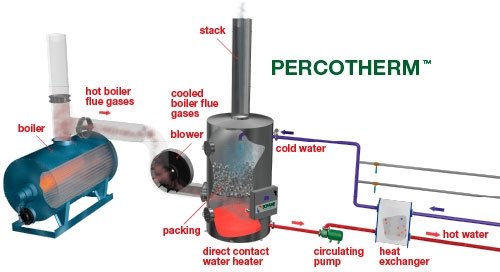
Percomtherm® Direct-Contact Condensing Stack Economizer
Recuperate up to 100% of the heat in a boiler's flue gas, flue gas temperatures as low as 50 °F (10°C)
The PERCOTHERM is a "DIRECT-CONTACT", condensing stack economizer which recuperates the residual heat contained in a boiler's flue gas and transfers this heat to a cold water stream. Hot water is produced at temperatures as high as 140°F (60°C).
The PERCOTHERM is a "DIRECT-CONTACT", condensing stack economizer which recuperates the residual heat contained in a boiler's flue gas and transfers this heat to a cold water stream. Hot water is produced at temperatures as high as 140°F (60°C).
Percotherm®
1Operation of a Condensing Stack Economizer
Cold water enters the unit at the top and is then uniformly distributed over the upper surface of a packing of stainless steel nodules which constitutes the heat transfer zone. The water percolates down through the packing where it comes in "direct-contact" with the rising, hot products of combustion. Both the sensible and latent heat contained in the gases are transferred to the water. The products of combustion are generated by existing boilers. The heated water collecting at the bottom of the unit is then pumped directly to the process, or across a plate and frame heat exchanger to transfer its energy to a process fluid.
2Applications of a Condensing Stack Economizer
Fresh air heating (via glycol loop), pre-heating of domestic water or boiler make-up water, and the heating of process water.
3Capacities of a Condensing Stack Economizer
The PERCOTHERM is available for connected boiler capacities varying from 100 HP to 100,000 lb steam/hr (1000 to 30,000 kW). If you require greater capacity, contact SOFAME.
Economizers
1Advantages of a Condensing Stack Economizer
- Very high efficiency; up to 100% (based on HHV). (Boiler seasonal efficiency improved by up to 20%).
- Maximum flue gas temperatures no more than 10°F (5.5°C) greater than cold water temperature at inlet.
- Minimum maintenance required.
- Reduced emission of atmospheric pollutants.
- No supervision required (unit is not classed as a pressure vessel).
- Reduction of installed boiler capacity.
- Can be installed outside.
2Markets
- Industrial
- Commercial
- Institutional
3Construction of a Condensing Stack Economizer
All wetted components and materials, including the unit's shell and the packing, are entirely fabricated of stainless steel, and are covered by a 5 year guarantee.
Flue Gas Condensers
1Introduction
Flue gases from large boilers are typically 450 - 650°F. Stack Economizers recover some of this heat for pre-heating water. The water is most often used for boiler make-up water or some other need that coincides with boiler operation. Stack Economizers should be considered as an efficiency measure when large amounts of make-up water are used (ie: not all condensate is returned to the boiler or large amounts of live steam are used in the process so there is no condensate to return) or there is a simultaneous need for large quantities of hot water for some other use. The savings potential is based on the existing stack temperature, the volume of make-up water needed, and the hours of operation. Economizers are available in a wide range of sizes, from small coil-like units to very large waste heat recovery boilers.
Flue Gas Condensers that are used when water and flue gases come in direct contact with each other.
2How They Work
Boiler stack economizers are simply heat exchangers with hot flue gas on one side and water on the other. Or, in direct contact condensing units, the make-up water is in direct contact with the flue gases. Economizers must be sized for the volume of flue gas, its temperature, the maximum pressure drop allowed through the stack, what kind of fuel is used in the boiler, and how much energy needs to be recovered. Economizers designed for natural gas only, would likely plug-up if installed on a coal boiler and would face increased risk of corrosion if installed on an oil-fired boiler. Some units are designed to keep the flue gases above condensation temperature, and others are made of materials that resist the corrosive effect of condensed flue gases.
3Economics
The savings potential is a function of how much heat can be recovered, which is a function of how much cold water needs to be heated. A generally accepted "rule of thumb" is that about 5% of boiler input capacity can be recovered with a properly sized economizer. A higher percentage can be recovered with a Flue Gas Condenser, assuming there is enough cold water to condense all of the flue gas that is available. Therefore, for 'ball parking' purposes, start by comparing boiler input capacity with the need to heat water.
For example: consider a 500 hp boiler with a gas input of 20 million BTUs per Hour.
20,000,000 BTUs x 5% = 1,000,000 BTUs (100% Load Factor)
1,000,000 BTUs / (1,200 BTUs per Gallon of 200F water) = 833 Gallons per Hour
(1,000,000 BTUs / 80% efficiency) = ~1.2 MCF x $7.00 per MCF Natural Gas = $8.40 per Hour Value
Savings is reduced by 50% for a 50% Load Factor, etc.
If there is a need for that much hot water, the savings potential of $8.40 per hour would be multiplied by the number of boiler run hours, or the number of hours that the hot water can be used. In each application, be sure to consider the boiler Load Factor, the efficiency that the hot water is otherwise produced at, the cost of natural gas, and the installation cost of the equipment.
If the economizer would be used to heat boiler make-up water, it is necessary to determine the volume and temperature at the inlet of the economizer. The lower the amount of condensate return, the higher the volume of make-up water and the higher savings potential.
An economizer that recovers 5% of boiler input should easily have a 2 year payback in a year-round application.
